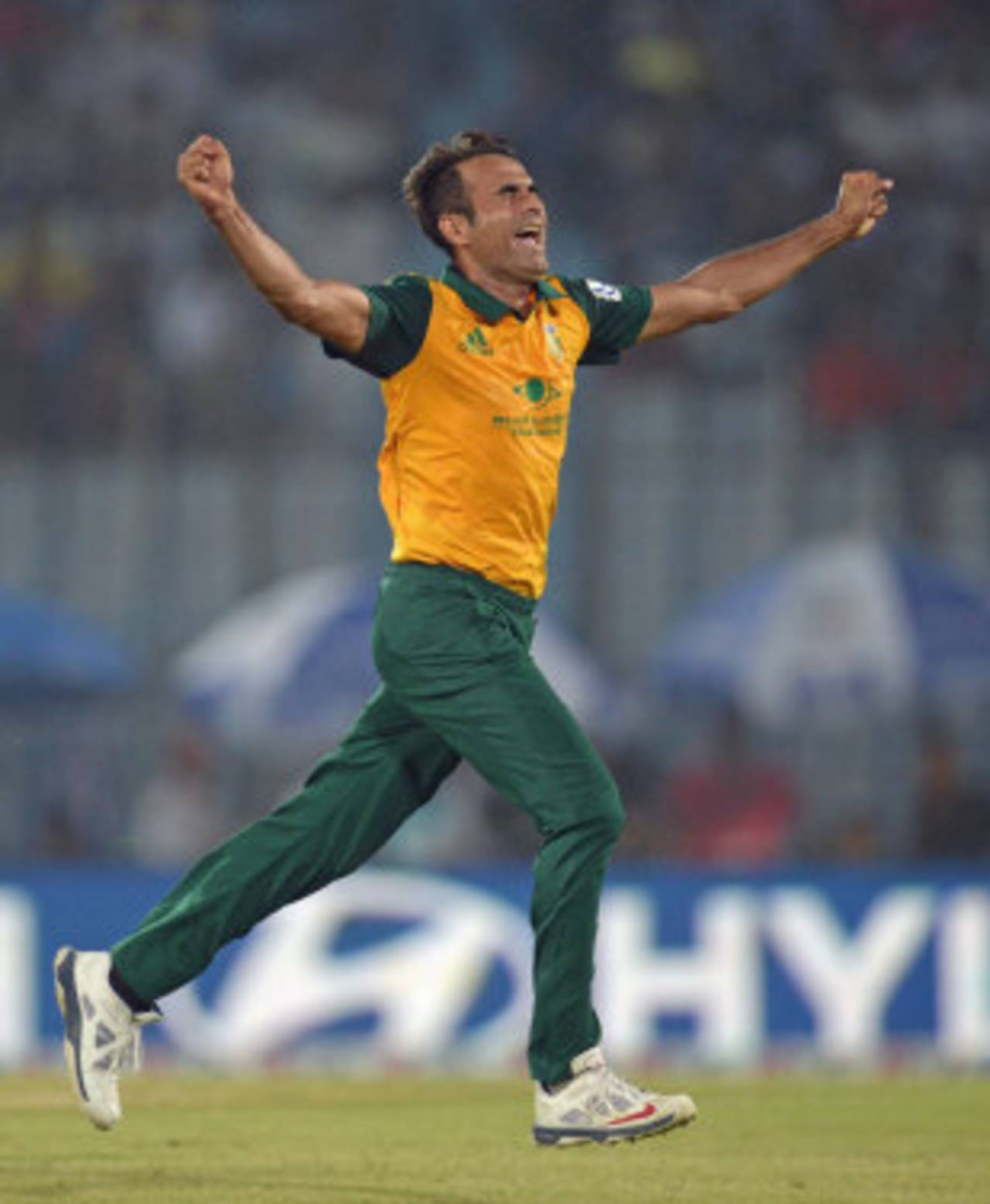The hand of the leggie
Legspinners have blossomed in the World T20, which has otherwise been an odd, somewhat ugly affair
Martin Crowe
05-Apr-2014

Imran Tahir has had a successful tournament after a tough outing in Tests and ODIs • Getty Images
The only saving grace for the World T20 extravaganza in Bangladesh has been legspin. It shone out like a beacon, a bright light amid dim, dull, boring behaviour. The art of legspin, so often missing in a game of bent proceedings, became the hero that flagged what is, hopefully, a new, genuine future.
So hats off to Samuel Badree, Imran Tahir, Amit Mishra, with high recommendations for the youngsters Seekkuge Prasanna and James Muirhead. The first three, in particular, provided the best bowling in the tournament, and easily the best cricket. It was skilful, legal, daring, courageous, all bowling against big bats, small boundaries, and fellow spinners with plenty of elbow grease.
The big three dominated not only the scoresheets but captured the minds of those who believe in a lost art in a crazy sport. And those two new kids on the block, Prasanna and Muirhead, better get a chance to shine more too, soon, for they are natural match-winners in the making.
Badree opened the bowling for West Indies and bowled all his allotted overs straight through. This gave every batsman a chance to size up not only his honest work but the vast open fields in the Powerplay overs. Thankfully Badree was stoic and ballsy. He moved in aggressively and with an energetic snap sent the ball accurately on its way, with enough rotation and spit to actively scythe through the finest so-called specialist openers on show. Badree was easily the best opening bowler in town, in T20 garb. And at only 85kph. His was a gutsy and resilient display.
Tahir has had a tough road to hoe as a Test and one-day legspinner. However, he may well return and prosper in those forms following his heroic effort carrying South Africa through to the semi-finals. He didn't blink. Instead he strode in with purpose and belief that his fast, skidding leggies would suffice, and by jeepers they did. The cocked Asian wrist sent a message to the batsmen that a bit of spin would arrive off a tiring surface, only for them to be fooled by the kick-on, the squeeze and the fizz that he generated. His accuracy and length were exquisite. He fooled them all. He enjoyed his rightful moment in the sun. It was sweet music to a previous worried trier. And another victory for legspin.
Yet the most glorious of them all has been Mishra, the diminutive Indian who stole the show. So often neglected for fingerspinners, he finally got his chance, because in Bangladesh in a short format, a third spinner was welcome. He got his chance against Pakistan in the opening game and he took it with all ten fingers. In India's first match, his second ball to Ahmed Shehzad left his cocked wrist and straight arm, floated high, drifted in, spun and bounced in sync, then kept spinning and defeated his Pakistani opponent, and as the door opened and the bails were met by a delighted Dhoni, it became the ball of the tournament, sending shivers across the land. The legspin magic was back. Mishra was the magician and the batsmen watching didn't know what to do.
Meanwhile, the tournament showed its ugly side. The dew and poor floodlights broke fingers. Fieldsmen lost heart and mind in the dim, wet outfields of Chittagong. The 15-degree rule was constantly broken as certain fingerspinners pretended to be bowlers. Fair catches were denied via two-dimensional technological bollocks. Batsmen lost their heads, Marlon Samuels his marbles. Kamran Akmal was seen playing, but no one could understand why.
On the flip, Virat Kohli was majestic, as was Glenn Maxwell disdainful and dismissive. Dale Steyn impressed for the nth year in a row, and Darren Sammy cleared many a row. At the helm, some captains showed poise, some didn't. Mahela Jayawardene made an unofficial return at the behest of Lasith Malinga, and Dhoni was fresh and full of enterprise, while Faf du Plessis refused to acknowledge that his best role was as a specialist fielder, and George Bailey believed he was in Darwin.
There were some awful tactics. Stuart Broad was brilliantly dreadful, but no one more so than Mushfiqur Rahim, the home-town skipper, who simply couldn't cope with being the keeper and No. 4, the janitor and the chef. He had not one clue how to marshal a bunch of misfits, and who could blame him. His senior player, Shakib Al Hasan, insisted that they all rest at home for 24 months, and while unfair on the groundsmen, the nation breathed a sigh of relief that sense had been shared and might prevail. If only.
And so it was left to Netherlands, those quirky Dutchmen in the orange outfits, showing their European masters that life isn't about reputation but about the moment you are in. England in red were embarrassing and red-faced. The Dutch, led by the Kiwi Peter Borren, showed a fervent national spirit via Stephan Myburgh, Wesley Barresi and Logan van Beek, while Mudassar Bukhari and Ahsan Malik added a touch of spice to the proceedings.
Overall, the tournament was an extremely odd affair. It was like Lady Diana dating Dodi Al Fayed: colourful, worldly and staged, and highly unpredictable. It lacked much, apart from the domination of the numerous elephants in the room. Oh dear, there were many of those - a few families, in fact. But in a little corner, tucked away, were the small of band of legspinners. They sat discussing their art, gesturing with wrist and twirl, cheerful smiles and genuine endeavour, and acknowledging they had, for now, won the day.
Actually, they won hands down.
Martin Crowe, one of the leading batsmen of the late '80s and early '90s, played 77 Tests for New Zealand